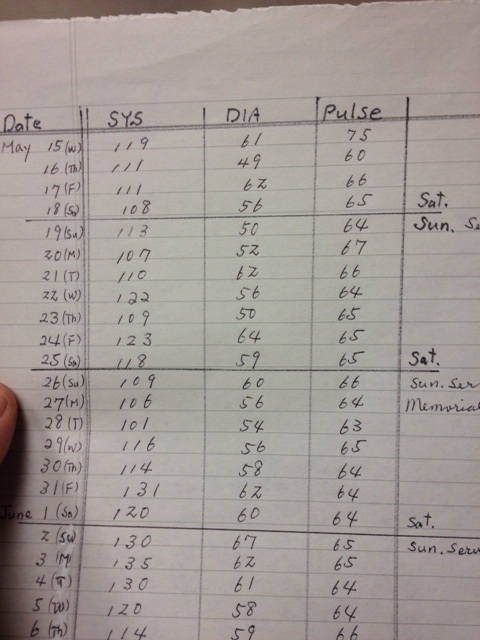"Doctor, I've been taking my vitals signs and they've been very stable, but recently I've noted I just have no "get-up-and-go." I feel short of breath climbing stairs now. Any idea what might be going on? Here's what I've recorded:"
 |
The patient's self-recorded vital signs
(Click to enlarge) |
So, what's the diagnosis?
(Hint: remember who the patient came to see...)
-Wes

Pacemaker failure?
ReplyDeleteThat could be anything. I had those same symptoms when I had breast cancer. But I can tell you that it's not hypertension. Man am I jealous of those numbers.
ReplyDeletePacer at ERI.
ReplyDeleteChronotropic Incompetence either real or hypochondriac induced. Or beginning HF.
ReplyDeleteAortic insufficiency with wide pulse pressure and low diastolic pressure
ReplyDeleteIt could be a lot of things....intermittent AF?
ReplyDeleteThe striking finding of these vital signs was the nearly consistent pulse noted after the 16th of May averaging about 65 b/min most occassions. The patient had a Medtronic dual chamber pacermaker implanted in 2005 for complete heart block which had reached its elective replacement indicator at 11pm on the 16th of May.
ReplyDeleteThe feature of most of Medtronic's more recent dual-chamber pacemaker devices is they switch from DDD mode (which tracks the patient's intrinsic sinus (atrial) rate), to VVI with lower rate of 65 b/min. The patient nicely documented this finding on her vital sign record. The loss of AV synchrony and fixed rate of 65 beats/minute (at both rest and with exercise) explains her sudden development of exertional shortness of breath and fatigue with exertion.
Sometimes, the pacer mode switch can be missed on EKG, too, as was seen in the EKG Du Jour #11 Case Study presented previously on this blog.